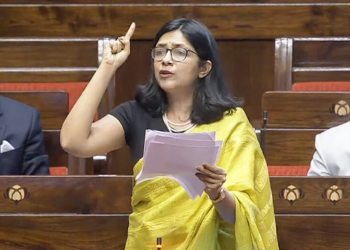New Delhi: Introducing three bills in the Lok Sabha, India prepares for a significant shift in its justice system. These bills aim to transform the system and eliminate colonial-era laws. They are not just amendments, but rather intentional steps towards progress, aiming to create a fair and inclusive future.
The bills suggest a thorough revamp of important legal codes that have faced criticism due to their complexity, lengthy processes, and biasness. Beyond being mere amendments, these bills represent the pulse of societal growth.
Revolutionary piece of legislation in its time, the Indian Evidence Act of 1872 made rules of admissibility of evidence in Indian courts uniform, and not prejudiced against certain people based on their caste, community, faith and social position.
The law was based on the work of the renowned scholar and the then Law Member of the Viceroy’s Executive Council, Sir James Fitzjames Stephen. It is now being proposed to be replaced by the Bharatiya Sakshya Adhiniyam
The Bhartiya Sakshya Adhiniyam Amendment Bill focuses on modernising the Indian Evidence Act of 1872. With 170 sections, the bill introduces 1 new section, amends 23 sections, and repeals 5 sections.
The amendments expand the definition of acceptable evidence to encompass electronic and digital records, such as emails, server logs, and smartphone messages. This change is expected to enhance the efficiency and reliability of evidence collection and presentation in court proceedings.
The definition of ‘documents’ is expanded to include electronic and digital records, such as emails, server logs, computer files, smartphone and laptop messages, websites, and location data.
“The Bharatiya Sakshya Bill, 2023 is a testament to modernise as well as Indianise the Indian Evidence Act. The 69th Law Commission Report, published in the year 1977, was the last major overhaul to the 1872 Act. Over the course of the decades, the 1872 Act witnessed some more changes, however a mammoth of a overhaul can be seen with the introduction of the Bharatiya Sakshya Bill, 2023,” Advocate Akanksha Mathur said.
Given the fact that the Act and the New Bill came after a span of decades, it is indicative that the New Bill has taken into consideration the electronic form of documents as well as technical/scientific documents so as to include the existing terms.
“This is evident from the clause 2 (c) (vi) of the New Bill, which has included “(vi) An electronic record on emails, server logs, documents on computers, laptop or smartphone, messages, websites, locational evidence and voice mail messages stored on digital devices are documents,” Advocate Mathur said.
“Each of these are now admissible in evidence like any other traditional document. The said amendment appears to take into account the present times, where offences are often committed in electronic form rather than in the traditional physical form. Though from 2000 onwards, the Courts in various judgments had held that ‘electronic evidence’ will be a document in terms of S.3 of the Indian Evidence Act, 1872, the amendment has incorporated the judgment of the various courts and has added it to the Statute,” Advocate Nitin Saluja told IANS.
“This expansion in the definition of the term document, places the New Bill at the same pedestal of progressiveness as its young counterparts that assist the ease of co – dependance of law and technology,” Advocate Mathur said.
The net effect of the amendment is that all the electronic evidence will be proved or disproved in the court like any other evidence without being entangled in the technicalities of whether the particular electronic record can be considered to be a document or not, said Advocate Saluja.
(IANS)















